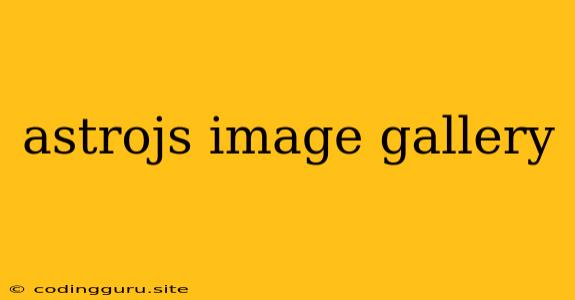AstroJS Image Gallery: A Comprehensive Guide to Building Stunning Visual Experiences
AstroJS, the lightning-fast static site generator, offers a fantastic foundation for creating beautiful and interactive image galleries. Its speed, SEO-friendliness, and ability to seamlessly integrate with other frameworks make it an excellent choice for showcasing your visual content. In this guide, we'll delve into the intricacies of building an AstroJS image gallery, exploring various techniques and best practices.
Why Choose AstroJS for Image Galleries?
Before we dive into the specifics, let's understand why AstroJS stands out for building image galleries:
- Blazing Fast Performance: AstroJS's static site generation ensures lightning-fast loading times, crucial for delivering an optimal user experience, especially for image-heavy content.
- Enhanced SEO: AstroJS's server-side rendering helps search engines easily index your gallery, improving your website's visibility and organic traffic.
- Component-Based Development: AstroJS promotes modularity with components, enabling you to easily manage and reuse image gallery elements across your website.
- Flexible Integration: AstroJS integrates seamlessly with popular frameworks like React, Vue, and Svelte, allowing you to leverage your existing skills and libraries.
Building Your AstroJS Image Gallery: Step-by-Step
Let's walk through the process of creating a basic image gallery using AstroJS:
1. Set up your AstroJS project:
-
If you haven't already, create a new AstroJS project using the Astro CLI:
npm create astro@latest my-image-gallery cd my-image-gallery
2. Define Your Image Data:
-
Create a JSON file to store your image data (e.g.,
images.json):[ { "src": "images/image1.jpg", "alt": "Image description 1", "title": "Image title 1" }, { "src": "images/image2.jpg", "alt": "Image description 2", "title": "Image title 2" }, // ... more image objects ]
3. Create Your Image Gallery Component:
-
In your
src/componentsdirectory, create a file namedImageGallery.astro:--- import { useState } from 'react'; import { loadImages } from 'astro:assets'; import images from '../images.json'; ----
{images.map((image, index) => (
-
-
4. Use Your Image Gallery Component:
-
In your
src/pages/index.astrofile, import and use theImageGallerycomponent:--- import ImageGallery from '../components/ImageGallery.astro'; ---My Image Gallery
5. Run your AstroJS development server:
-
Start your development server using:
npm run dev -
Access your image gallery at
http://localhost:5173/.
Advanced Features: Enhancing Your Image Gallery
Now that we have a basic gallery, let's explore some advanced features to make it more interactive and visually appealing:
1. Image Lightbox/Modal:
* **Using a Library:** You can leverage libraries like **Lightbox** to provide a lightbox experience for enlarged images.
* **Implementing from Scratch:** Alternatively, you can build a lightbox using AstroJS's component-based architecture, creating a custom modal element to display the full-size image.
2. Image Carousel:
* **Leveraging a Library:** Utilize libraries like **Swiper** for smooth image carousels with options for navigation and auto-play.
* **Creating a Custom Carousel:** You can build a custom image carousel using AstroJS's component capabilities, allowing you to control the slider's behavior and appearance.
3. Image Filtering/Categorization:
* **Using Data Attributes:** Add data attributes to your images for categorization (e.g., `data-category="landscape"`).
* **Implementing Filtering Logic:** Create a filtering system using AstroJS's client-side logic or JavaScript to filter images based on their categories.
4. Responsive Design:
* **Media Queries:** Use CSS media queries to ensure your image gallery adapts to different screen sizes, providing an optimal viewing experience across devices.
5. Lazy Loading:
* **Optimize Performance:** Employ lazy loading for images to improve initial page load times, particularly for large galleries.
6. Accessibility:
* **Alternative Text (alt) Attributes:** Ensure every image has descriptive `alt` attributes for screen readers and visually impaired users.
* **Keyboard Navigation:** Make your gallery keyboard-accessible using ARIA attributes.
Tips for Building a Stellar AstroJS Image Gallery:
- Optimize Image Sizes: Use appropriate image formats (JPEG, WebP) and compress images to reduce file sizes without compromising quality.
- Caching Strategies: Leverage browser caching and CDNs to speed up image delivery.
- Use a CSS Framework: Utilize CSS frameworks like Tailwind CSS or Bootstrap to streamline styling and ensure consistency.
- Prioritize User Experience: Consider factors like loading speed, navigation ease, and responsiveness for an engaging experience.
Conclusion
AstroJS provides a powerful framework for crafting elegant and high-performance image galleries. By leveraging its static site generation, component-based development, and seamless integration capabilities, you can build stunning visual experiences that engage your audience and elevate your website's appeal. Remember to prioritize performance, accessibility, and user experience while implementing advanced features like lightboxes, carousels, and filtering. With these guidelines, you can transform your ideas into captivating image galleries using AstroJS.
